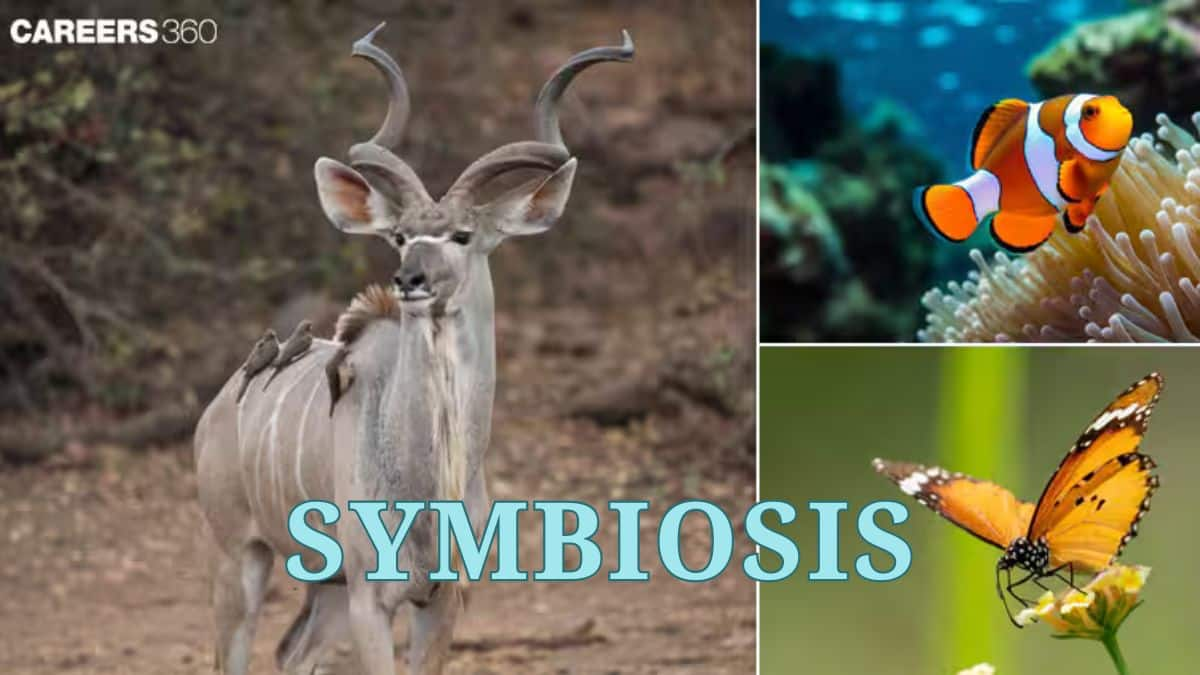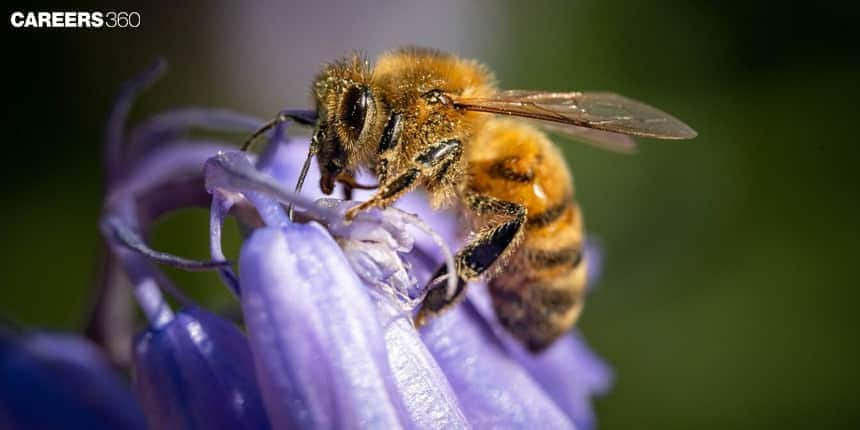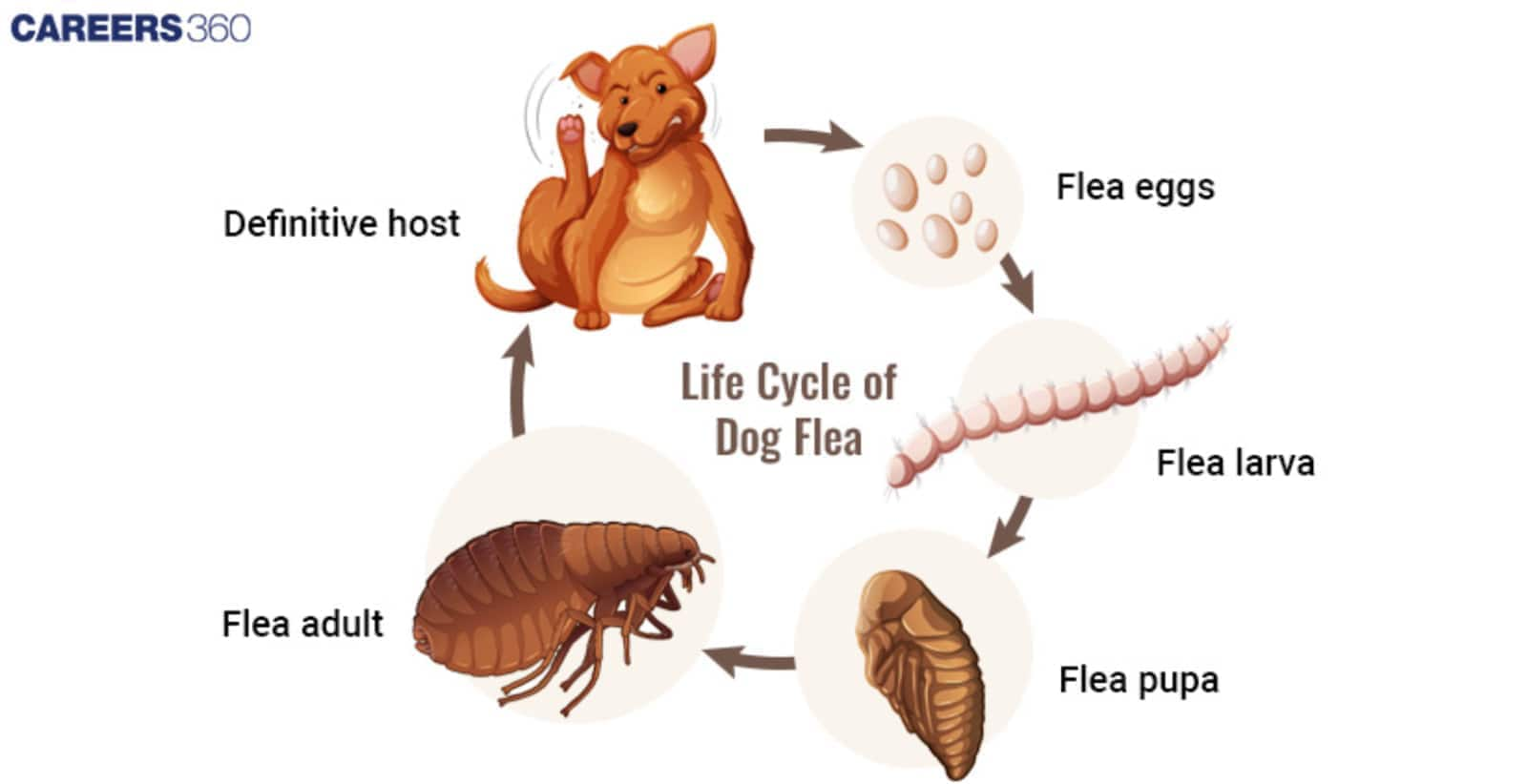Symbiosis: Definition, Meaning, Overview, Examples, Types
Symbiosis is a biological interaction where two different species live together in close association. It includes mutualism, commensalism, parasitism, amensalism, and neutralism. These interactions influence survival, reproduction, and ecosystem balance, making it an important Class 12 Biology and NEET concept.
This Story also Contains
- What is Symbiosis?
- Importance of Symbiosis in Biology
- Types of Symbiosis
- Comparison of Different Types of Symbiosis
- Examples of Symbiotic Relationships in Nature
- Population Interactions NEET MCQs (With Answers & Explanations)

What is Symbiosis?
Symbiosis refers to the mutual relationship between two different living organisms that can interact for an extended period depending on the kind of symbiosis. Symbiosis is a close, long-term interaction between two different species. This kind of relationship is commonly known as a symbiotic relationship.
Symbiosis depends on the kind of interaction involved between species, such as mutualism where both species benefit, commensalism where one benefits and does not affect the other and parasitism where one species benefits at the expense of another. Symbiotic relations are important for the interpretation of ecosystems because they put across the idea that they are interconnected and dependent on each other.
Importance of Symbiosis in Biology
Symbiosis in biology involves several kinds of associations, including mutualism, commensalism, and parasitism, which describes different relationships. In ecology, the role of symbiosis is underscored in shaping ecosystems and driving evolution.
There are symbiotic relationships found throughout nature. Lichens are an example of a symbiotic association between fungi and algae, mycorrhizal fungi and plant roots, and clownfish and sea anemones. In general, symbiosis helps study how such interactions influence survival, reproduction, and adaptation.
Types of Symbiosis
The types of symbiosis are described below-
Mutualism
When both the involved species benefit from the arrangement, the symbiotic relationship is known as mutualism. Such a relationship can improve the existence and breeding of both species. For example, bees feed on honey that is collected from flowers and transfer pollen needed for the production of seeds onto the flowers.
Mutualistic Relationship between Bees and Flowers

Commensalism
Commensalism is another symbiotic relationship that is interspecies, one of the species benefits while the other remains unbothered. An example is, the barnacles and the whales. Barnacles are parasitic creatures that cling to the whale's skin for space to live, the whale is not harmed.
Commensal relationship between Barnacles and Whales

Parasitism
Parasitism is a type of symbiosis where one organism called the parasite benefits while the other one called the host is harmed. Such a relationship most likely hurts the host organism. An example is the association of fleas and dogs. The flea is a parasite that has a host and the host is the dog. The parasite feeds on the dog’s blood leading to uneasiness and even other health complications for the host.
Parasitic relationship between Flea and Dog

Amensalism
Amensalism is the type of symbiosis in which one of the species is harmed or even killed with no impact on the other partner. An example is the discharge of chemical substances by some plants to retard the growth of other encroaching plants like the black walnut tree synthesizes jungle.
Neutralism
Neutralism is when two species tolerate each other’s presence and do not interact. It is rare because no relation is completely free of any effect. An example might be a spider living with a cactus in the desert, in which the two are not enemies.
Comparison of Different Types of Symbiosis
The table below shows the effects of different types of symbiotic interactions on both the species:
Type of Symbiosis | Effect on Species A | Effect on Species B |
Mutualism | Positive | Positive |
Commensalism | Positive | Neutral |
Parasitism | Positive | Negative |
Amensalism | Negative | Neutral |
Neutralism | Neutral | Neutral |
Examples of Symbiotic Relationships in Nature
Various examples of symbiotic interaction can be seen in nature:
Lichens (Algae + Fungi)
Lichen shows mutualism where algae perform photosynthesis to provide food and fungi offer protection.
Mycorrhizal Fungi and Roots
Mycorrhizal fungi increase nutrient and water absorption for plants, especially phosphorus, while plants provide carbohydrates to fungi.
Bees and Flowers
Bees collect nectar and pollen as food, while flowers benefit from pollination.
Barnacles and Whales
Barnacles attach to the whale’s skin and gain mobility to access nutrient-rich waters without harming the whale.
Clownfish and Sea Anemones
Clownfish get protection from predators by living among the stinging tentacles of sea anemones which have stinging tentacles, while clownfish provide nutrients through waste.
Population Interactions NEET MCQs (With Answers & Explanations)
This topic carries a significant weightage in NEET exam. Following topics are important while preparing for the exam:
Types of Symbiotic Interactions
Examples of each Symbiotic Interaction
Comparison between different Interactions
Practice Questions for NEET
Q1. Amensalism is an association between two species where:
One species is harmed and the other is benefitted.
One species is harmed and the other is unaffected.
One species is benefitted and the other is unaffected.
Both species are harmed.
Correct answer: 2) One species is harmed and the other is unaffected.
Explanation:
An ecological relationship known as amensalism occurs when one species suffers harm while the other species is unscathed. This interaction can take many different forms, but it is frequently observed when one species physically prevents another from growing or surviving, or when one creature creates a material that is toxic to another.
The interaction between some plants and their environment is a well-known illustration of amensalism. Allelopathic compounds, for example, are released into the soil by certain plants and prevent the growth of competing plants in the vicinity. In this instance, the chemicals damage the rival plants but do not affect the plant that produces them.
Hence, the correct answer is option 2) one species is harmed and the other is unaffected.
Q2. Epiphytes that are growing on a mango branch are an example of which of the following?
Amensalism
Commensalism
Mutualism
Predation
Correct answer: 2) Commensalism
Explanation:
Epiphytes are plants that grow on the surface of other plants, such as mango trees, for physical support. They do not enter into the host tissues or withdraw water and nutrients from the host plant. They obtain moisture and nutrients from the air, rain, or debris around them. Such a relationship is an example of commensalism, a symbiotic relationship where one organism is affected, but the other one is not.
Hence, the correct answer is option 2) Commensalism.
Q3. Who stands to gain from the ungulates?
Sponges
Virus
Bacteria
Grass
Correct answer: 3) Bacteria
Explanation:
Bacteria found in ungulate intestines help them. Because many of them are herbivores, gut bacteria aid in cellulose breakdown. The majority of gut microorganisms are anaerobic.
Several even-toed ungulates have symbiotic relationships with microbes. The mammals profit from this mutually advantageous connection because it allows them to convert cellulose into a type of glucose that they can consume, as well as other digestive advantages, while the microbes gain from food and shelter.
Ungulates are members of the group Ungulata, which consists mostly of big animals with hooves. Horses, rhinoceroses, and tapirs are examples of odd-toed ungulates, while cattle, pigs, giraffes, camels, sheep, deer, and hippopotamuses are examples of even-toed ungulates.
Sponges are a fundamental animal category and the diploblastic sister of the phylum Porifera. These are multicellular creatures with pores and channels that let water move through their bodies, which are made of jelly-like mesohyl sandwiched between two thin layers of cells.
Hence, the correct answer is option 3) Bacteria.
Also Read:
Frequently Asked Questions (FAQs)
Biology tells us that symbiosis has to do with the close or long-term association that two different biological organisms have with each other. Such relationships can be symbiotic, competitive, parasitic, adverse, or indifferent, and they affect the life, development, and adaptation of individuals.
The different types of symbiosis include: The different types of symbiosis include:
Mutualism: In a way, both species are in it for the taking.
Commensalism: One species is benefited while the other species remains unaffected, positive as well as negative impacts are absent.
Parasitism: The two species live in an environment in which one gains at the loss of the other.
Amensalism: The population of one species is held back or eradicated in some manner while the other is not.
Neutralism: The two species are somehow in different environments and do not intervene in the affairs of the other.
The main difference between mutualism and commensalism is that in mutualism, both species that are involved in the interaction gain something in return, while the organism in commensalism benefits while the other neither helps nor harms them. For instance, bees feed directly upon the nectar; therefore, they are getting what they require while on the other hand, flowers benefit from the pollination behaviours of bees. The type of symbiotic relationship which exists between barnacles and whales is mutualism because barnacles receive shelter and a source of food from the body of the whale and in return, it has no negative impact on the whale.
Examples of parasitism include:
Fleas on dogs: Fleas suck the blood of the dog hence irritating the skin and or resulting in some diseases that affect the dog.
Tapeworms in humans: Tapeworms are parasites in the human body they literately live in the intestines and feed on nutrients hence causing malnutrition and other complications among other health complications for the host.
Mistletoe on trees: Mistletoe parasites nutrients and water from the trees which causes the slow death of the tree that hosts the plant.
Multiplex cooperation is twice healthcare for ecosystems because it underpins the ecological and evolutionary dynamics of communities, as well as any changes affecting the survival, reproduction, and evolution of species. These interactions help mend the ecosystems by enhancing the availability of nutrients, energy flow, and the balance of the ecosystem.